Understanding Meningitis: Causes, Symptoms, and Prevention
Meningitis is the inflammation of the membranes around the brain and spinal cord and can affect individuals of all ages, with infants being most vulnerable. It can be transmitted through respiratory secretions and has various routes of infection. The types of meningitis include bacterial, viral, fungal, parasitic, and non-infectious. Different risk factors and symptoms are associated with neonatal and viral meningitis, emphasizing the importance of prompt diagnosis and treatment.
Download Presentation

Please find below an Image/Link to download the presentation.
The content on the website is provided AS IS for your information and personal use only. It may not be sold, licensed, or shared on other websites without obtaining consent from the author. Download presentation by click this link. If you encounter any issues during the download, it is possible that the publisher has removed the file from their server.
E N D
Presentation Transcript
Definition Meningitis is the inflammation of the membranes surrounding the brain & spinal cord, including the dura, arachinoid & pia matter.
Epidemiology Meningitis can occur at all ages but it is commonest in infancy. 95% of the cases take place between 1 month- 5 years of age.
Epidemiology The bacteria are transmitted from person to person through droplets of respiratory or throat secretions. Close and prolonged contact (e.g. sneezing and coughing on someone, living in close quarters or dormitories (military recruits, students), sharing eating or drinking utensils, etc.)
Routes of Infection Nasopharynx Blood stream Direct spread (skull fracture, meningo and encephalocele) Middle ear infection Infected Ventriculoperitoneal shunts. Congenital defects Sinusitis
Types Bacterial Viral (aseptic) Fungal Parasitic Non-infectious
Neonates Suspect meningitis with temperature more than 38.2 C Risk factors: Infective illness in mother PROM Difficult delivery Premature babies Spina bifida
Viral meningitis Viral meningitis comprises most aseptic meningitis syndromes. The viral agents for aseptic meningitis include the following: Enterovirus (polio virus, Echovirus, Coxsackievirus ) Herpesvirus (Hsv-1,2, Varicella.Z,EBV ) Paramyxovirus (Mumps, Measles) Togavirus (Rubella) Rhabdovirus (Rabies) Retrovirus (HIV)
Child with fever During interview try to establish: How is fever looks like when the child started to have fever, how is fever mesaured, how often fever recurrent? What antipyretic drugs was used and in which dose? Contact with antoher ill person, person with fever or infectious disease Additional symptoms: respiratory tract infection, diarohea, chang a child behaviour, change appearance of the child, skin leasions, confusion, lost of appetite, weight lost
Child with fever During interview try to establish: Vaccination history Pregnancy, birth, feeding Additional diseases Earlier hospitalizations Any travel Animlas in home Exposision for the sun
Child with fever Physical examination should be perform very carefully: General apperance Look for origin of infection Skin (rashes, purpura, petechiae) Hydratation Capillary refill time Breathing (dyspnoe, tachypnoe, wheezing) Meningeal sign
Child with fever AVPU scale: A (alert) conscious, logical contact V (verbal) answer for the voice P (pain) pain reaction U (unreactive) unconscious, no reaction
If you thought of lumbar puncture - do it
Contraindication for LP Increase intracranial pressure. Unstable patient. Skin infection at site of LP. Thrombocytopenia. Papilloedema.
Treatment STEROIDS: to reduce cerebral edema and to prevent subsequent fibrosis & subsequent obstruction to CSF Dexaven 0,6mg/kg/day divided for 4 doses = 0,15mg/kg/dose
Treatment MANNITOL: to reduce cerebral edema 1-2g/kg/day divided for 4 doses
Prevention VACCINATIONS
Surviving Sepsis Campaign: International Guidelines for Management of Sepsis and Septic Shock: 2016
Sepsis-3 Definitions Sepsis: Life-threatening organ dysfunction caused by dysregulated host response to infection Septic Shock: Subset of sepsis with circulatory and cellular/metabolic dysfunction associated with higher risk of mortality JAMA. 2016;315(8):801-810. doi:10.1001/jama.2016.0287
SSC Guidelines and Sepsis-3 Definitions Sepsis in place of Severe Sepsis Sepsis-3 clinical criteria (i.e. qSOFA) were not used in studies that informed the recommendations in this revision Could not comment on use of Sepsis-3 clinical criteria JAMA. 2016;315(8):801-810. doi:10.1001/jama.2016.0287
Recommendations 93 Recommendations 32 Strong recommendations: We recommend 39 Weak recommendations: We suggest 18 Best Practice Statements No recommendation provided for 4 PICO questions
2012 Recommendation for Initial Resuscitation. We recommend the protocolized, quantitative resuscitation of patients with sepsis- induced tissue hypoperfusion. During the first 6 hours of resuscitation, the goals of initial resuscitation should include all of the following as a part of a treatment protocol: a) CVP 8 12 mm Hg b) MAP 65 mm Hg c) Urine output 0.5 mL/kg/hr d) Scvo2 70%.
Sepsis and septic shock are medical emergencies and we recommend that treatment and resuscitation begin immediately. Best Practice Statement
Antibiotics We recommend that administration of IV antimicrobials be initiated as soon as possible after recognition and within 1 h for both sepsis and septic shock. (strong recommendation, moderate quality of evidence). We recommend empiric broad-spectrum therapy with one or more antimicrobials to cover all likely pathogens. (strong recommendation, moderate quality of evidence).
Initial Resuscitation We recommend that in the resuscitation from sepsis-induced hypoperfusion, at least 30ml/kg of intravenous crystalloid fluid be given within the first 3 hours. (Strong recommendation; low quality of evidence) We recommend that following initial fluid resuscitation, additional fluids be guided by frequent reassessment of hemodynamic status. (Best Practice Statement)
Fluid Therapy We recommend crystalloids as the fluid of choice for initial resuscitation and subsequent intravascular volume replacement in patients with sepsis and septic shock (Strong recommendation, moderate quality of evidence). We suggest using albumin in addition to crystalloids when patients require substantial amounts of crystalloids (weak recommendation, low quality of evidence).
We recommend an initial target mean arterial pressure of 65 mmHg in patients with septic shock requiring vasopressors. (Strong recommendation; moderate quality of evidence)
Vasoactive agents We recommend norepinephrine as the first choice vasopressor (strong recommendation, moderate quality of evidence). We suggest adding either vasopressin (up to 0.03 U/min) or epinephrine to norepinephrine with the intent of raising MAP to target, or adding vasopressin (up to 0.03 U/min) to decrease norepinephrine dosage. (weak recommendation, low quality of evidence)
Lactate can help guide resuscitation We suggest guiding resuscitation to normalize lactate in patients with elevated lactate levels as a marker of tissue hypoperfusion. (Weak recommendation; low quality of evidence)
Summary Start resuscitation early with source control, intravenous fluids and antibiotics. Frequent assessment of the patients volume status is crucial throughout the resuscitation period. We suggest guiding resuscitation to normalize lactate in patients with elevated lactate levels as a marker of tissue hypoperfusion.
Diagnosis 1. We recommend that appropriate routine microbiologic cultures (including blood) be obtained before starting antimicrobial therapy in patients with suspected sepsis and septic shock if doing so results in no substantial delay in the start of antimicrobials. (BPS) Remarks: Appropriate routine microbiologic cultures always include at least two sets of blood cultures (aerobic and anaerobic).
Antibiotics We suggest empiric combination therapy (using at least two antibiotics of different antimicrobial classes) aimed at the most likely bacterial pathogen(s) for the initial management of septic shock. (Weak recommendation; low quality of evidence)
Antibiotics We suggest that combination therapy not be routinely used for on-going treatment of most other serious infections, including bacteremia and sepsis without shock. (Weak recommendation; low quality of evidence). We recommend against combination therapy for the routine treatment of neutropenic sepsis/bacteremia. (Strong recommendation; moderate quality of evidence).
CORTICOSTEROIDS 1. We suggest against using intravenous hydrocortisone to treat septic shock patients if adequate fluid resuscitation and vasopressor therapy are able to restore hemodynamic stability. If this is not achievable, we suggest intravenous hydrocortisone at a dose of 200 mg per day. (Weak recommendation; low quality of evidence)
GLUCOSE CONTROL 1. We recommend a protocolized approach to blood glucose management in ICU patients with sepsis, commencing insulin dosing when 2 consecutive blood glucose levels are >180 mg/dL. This approach should target an upper blood glucose level 180 mg/dL rather than an upper target blood glucose 110 mg/dL. (Strong recommendation; high quality of evidence) 2. We recommend that blood glucose values be monitored every 1 to 2 hrs until glucose values and insulin infusion rates are stable, then every 4 hrs thereafter in patients receiving insulin infusions. (BPS)
GLUCOSE CONTROL 3. We recommend that glucose levels obtained with point-of-care testing of capillary blood be interpreted with caution, as such measurements may not accurately estimate arterial blood or plasma glucose values. (BPS) 4. We suggest the use of arterial blood rather than capillary blood for point of care testing using glucose meters if patients have arterial catheters. (Weak recommendation; low quality of evidence)
Renal Replacement Therapy We suggest against the use of renal replacement therapy in patients with sepsis and acute kidney injury for increase in creatinine or oliguria without other definitive indications for dialysis. (Weak recommendation; low quality of evidence)
Nutrition We recommend against the administration of early parenteral nutrition alone or parenteral nutrition in combination with enteral feedings (but rather initiate early enteral nutrition) in critically ill patients with sepsis or septic shock who can be fed enterally. (Strong recommendation; moderate quality of evidence)
Nutrition We recommend against the administration of parenteral nutrition alone or in combination with enteral feeds (but rather to initiate IV glucose and advance enteral feeds as tolerated) over the first 7 days in critically ill patients with sepsis or septic shock in whom early enteral feeding is not feasible. (Strong recommendation; moderate quality of evidence).
Nutrition We suggest the early initiation of enteral feeding rather than a complete fast or only IV glucose in critically ill patients with sepsis or septic shock who can be fed enterally. (Weak recommendation; low quality of evidence) We suggest either early trophic/hypocaloric or early full enteral feeding in critically ill patients with sepsis or septic shock; if trophic/hypocaloric feeding is the initial strategy, then feeds should be advanced according to patient tolerance. (Weak recommendation; moderate quality of evidence)
Nutrition We suggest against routinely monitoring gastric residual volumes in critically ill patients with sepsis or septic shock. (Weak recommendation; low quality of evidence). However, we suggest measurement of gastric residuals in patients with feeding intolerance or who are considered to be high risk for aspiration. (Weak recommendation; very low quality of evidence)
Nutrition We suggest the use of prokinetic agents in critically ill patients with sepsis or septic shock and feeding intolerance. (Weak recommendation; low quality of evidence)
Invasive meningococcal disease Etiology and pathogenesis: The bacteria attach to and multiply on the mucosal cells of the nasopharynx. In a small proportion (less than 1%) of colonized persons, the organism penetrates the mucosal cells and enters the bloodstream. The bacteria spread by way of the blood to many organs. In about 50% of bacteremic persons, the organism crosses the blood brain barrier into the cerebrospinal fluid and causes purulent meningitis. An antecedent upper respiratory infection (URI) may be a contributing factor.
Invasive meningococcal disease Etiology and pathogenesis: Neisseria meningitidis B,C, W-135, Y, A Child > 2 months, rarely adults Peak incidence: 2-4 rok ycia and teenagers Incubation period: 3 to 4 days, with a range of 2 to 10 days Transmission: by droplet aerosol or secretions from the nasopharynx of colonized persons
Invasive meningococcal disease MENINGITIS Fever Vomits Severe headache Neck stiffness Photophoby Somolence/uncosciousness Seizure Characteristic skin leasions SEPSIS Fever Vomits Cold hands/ foots Pale skin Severe limb, joint, muscle pain tachypnoe, tachykardia Abdominal pain, rarely diarohea Characteristic skin leasions somolence/uncosciousness























